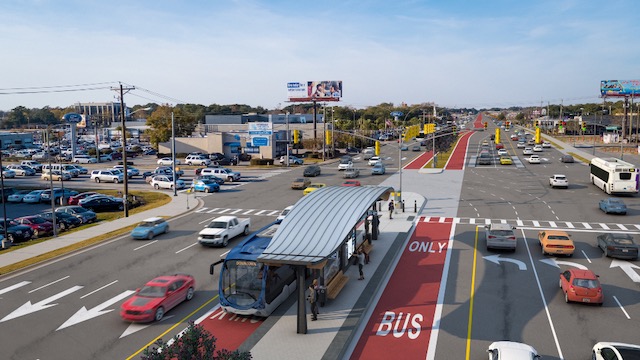Back when I first began studying light rail, one of my first questions was, “Why rail when buses can work just as well for a lot less money?” That question is becoming less valid today as transit agencies have done their usual job of making something affordable into something grossly expensive.
Proposed Charleston bus rapid transit line. Graphic by Low Country Rapid Transit.
A case in point is Charleston, South Carolina’s proposal for a bus rapid transit line. Local backers have the audacity to call it South Carolina’s first mass transit system, as if Columbia, Greenville, Charleston, and other South Carolina cities haven’t had bus systems for decades. But the real problem is that they want to spend $625 million on a 21-mile line, or about $30 million per mile.
Back in 2004, Kansas City built one of the nation’s first bus rapid transit lines, a six-mile route for $20.9 million. Not $20.9 million per mile but a total of $20.9 million, or about $3.5 million per mile. That would be about $5.5 million in today’s dollars. Kansas City opened a second line in 2011 that cost $30 million, but it was 13 miles long, so in today’s dollars it was only about $3.0 million per mile. In 2019, Kansas City extravagantly opened a third line costing $5.4 million a mile, under $6.0 million a mile in today’s money.
Charleston’s proposal is hardly the nation’s most expensive bus rapid transit projects. Pittsburgh is spending $41 million per mile on a 7.1-mile bus line. New York City is planning to spend $42 million a mile on a 6.1-mile route. Atlanta wants to spend $46 million a mile on its own 6.0-mile route.
Little Rochester, Minnesota (population: 121,000) wants to spend more than $49 million a mile on a 2.9-mile line. Houston is planning to spend more than $1.5 billion or $62 million a mile on a 25-mile route. But the cost/mile record so far is taken by Fairfax County, Virginia, which is spending almost $99 million a mile on a 7.4-mile bus route.
The insanity has spread to Kansas City as well. Disillusioned by having some of the most efficient bus rapid transit lines in the country, the city is planning to spend $330 million to turn 3 miles of one of those lines into a streetcar.
All of these projects are in line with the proposition that you can’t have “real” mass transit unless you soak the taxpayers for a huge amount of money (not to mention make streets more congested by dedicating lanes exclusively to transit). Any of these costs are expensive enough to have given pause to light-rail planners 30 years ago. Yet no one blinks an eye when the federal government announces it is funding such projects today. Local groups in each of these cities should stand up against such wasteful spending.









One would think cities like Kansas City ,the City of thousand fountains and Charleston in its architectural splendor would stoop to low ball rail streetcars like New Orrrrlins or San Francisco…. this cements idea I had to pick up bus riders. Buses that look like trains…..
https://i.pinimg.com/736x/f4/2d/f6/f42df6547088d30a5f22f6366ffcff2d–buses-rv.jpg
You can even have them emit steam…..dry ice.
The boondoggles get more and more outrageous, don’t they?
“Local groups in each of these cities should stand up against such wasteful spending.”
… as should national groups.
Remember, none of these boondoggles would get federal funds without first being approved by career professional employees working for FTA. Where are the nationwide groups like taxpayers’ associations and the AAA?
What power do local groups have in demanding stewardship in federal funds?
OPM — Other Peoples’ Money.
See: Free Lunch, No such thing as a …
What is this money going into? You start looking at a program like Rochester’s and you realize a lot of the money is for stuff not needed to run a BRT.
Like they’re buying a dozen _electric_ buses. RTD recently canceled an order in part because of the huge expense of an electric bus shed. RTD said they’d have to build a $85M bus shed for those 17 electric buses. The expense isn’t merely twice that of trad buses, but the killer is all the infrastructure you need to build out.
In short, they could cut a big chunk of the cost of the project off just by dropping the EV aspect. You could do more with less buses.
But it’s someone elses money.